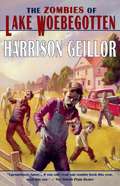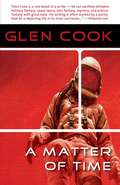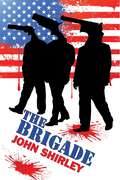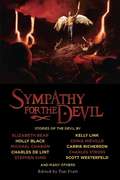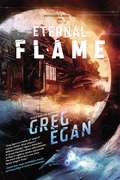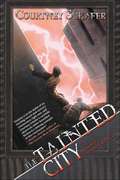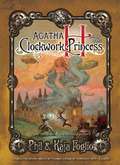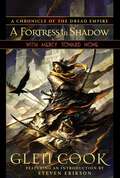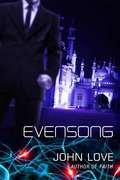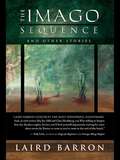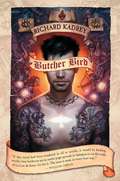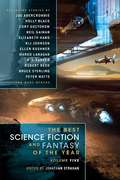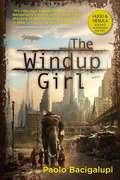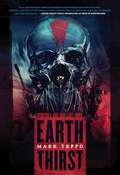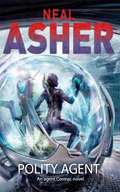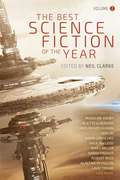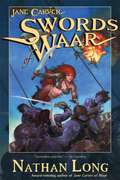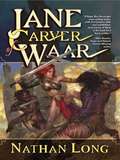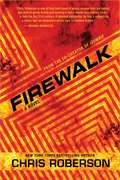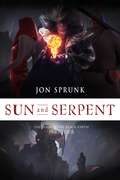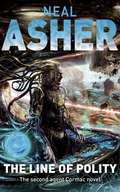- Table View
- List View
The Zombies of Lake Woebegotten
by Harrison GeillorThe town of Lake Woebegotton, MN is a small town, filled with ordinary (yet above average) people, leading ordinary lives. Ordinary, that is, until the dead start coming back to life, with the intent to feast upon the living! Now this small town of above average citizens must overcome their petty rivalries and hidden secrets in order to survive an onslaught of the dead.
A Matter of Time
by Glen CookMay 1975. St. Louis. In a snow-swept street, a cop finds the body of a man who died fifty years ago. It's still warm.July 1866, Lidice, Bohemia: A teenage girl calmly watches her parents die as another being takes control of her body.August 2058, Prague: Three political rebels flee in to the past, taking with them a terrible secret.As past, present, and future collide, one man holds the key to the puzzle. And if he doesn't fit it together, the world he knows will fall to pieces. It's just A Matter of Time.
The Brigade
by John ShirleySaturday night in sleepy ultraconservative Salton, Oregon has turned terrifying. For thirteen weeks a killer has struck and a young woman has been viciously murdered. With all-American gumption and a lack of concern of legal niceties, the town has taken things into its own hands and formed the Town Security Brigade. Sure enough, the good-old-boy vigilantes seem to have scared the psychokiller away -- until reporter Anna Wimple shows up asking questions about the Brigade's rough justice. Anna becomes victim number fourteen -- or does she? No one is going to find out because the Brigade covers up her death.As the power of the Brigade grows, only two of Salton's residents seem to have the courage to stand against them. Tony -- 18 years-old, precocious, bright, anti-authoritarian -- and Sonja, his beautiful 25-year-old high school principal. As they uncover the truth, they mark themselves for death. Sonja is abducted and Tony -- with the help of doper mechanic Hustle Brodyboy -- must find her.
Sympathy for the Devil
by Tim PrattThe Devil is known by many names: Serpent, Tempter, Beast, Adversary, Wanderer, Dragon, Rebel. His traps and machinations are the stuff of legends. His faces are legion. No matter what face the devil wears, Sympathy for the Devil.
The Eternal Flame (Orthogonal)
by Greg EganGreg Egan&’s The Clockwork Rocket introduced readers to an exotic universe where the laws of physics are very different from our own, where the speed of light varies in ways Einstein would never allow, and where intelligent life has evolved in unique and fascinating ways. Now Egan continues his epic tale of alien beings embarked on a desperate voyage to save their world . . . .The generation ship Peerless is in search of advanced technology capable of sparing their home planet from imminent destruction. In theory, the ship is traveling fast enough that it can traverse the cosmos for generations–and still return home only a few years after they departed. But a critical fuel shortage threatens to cut their urgent voyage short, even as a population explosion stretches the ship&’s life-support capacity to its limits.When the astronomer Tamara discovers the Object, a meteor whose trajectory will bring it within range of the Peerless, she sees a risky solution to the fuel crisis. Meanwhile, the biologist Carlo searches for a better way to control fertility, despite the traditions and prejudices of their society. As the scientists clash with the ship&’s leaders, they find themselves caught up in two equally dangerous revolutions: one in the sexual roles of their species, the other in their very understanding of the nature of matter and energy.The Eternal Flame lights up the mind with dazzling new frontiers of physics and biology, as only Greg Egan could imagine them.
The Tainted City (The Shattered Sigil)
by Courtney SchaferDev is a desperate man. After narrowly surviving a smuggling job gonewrong, he&’s now a prisoner of the Alathian Council, held hostage toensure his friend Kiran - former apprentice to one of the mostruthless mages alive - does their bidding.But Kiran isn&’t Dev&’s only concern. Back in his home city of Ninavel,the child he once swore to protect faces a terrible fate if he can&’treach her in time, and the days are fast slipping away. So when theCouncil offers Dev freedom in exchange for his and Kiran&’s assistancein a clandestine mission to Ninavel, he can&’t refuse, no matter howmuch he distrusts their motives.Once in Ninavel the mission proves more treacherous than even Devcould have imagined. Betrayed by allies, forced to aid their enemies,he and Kiran must confront the darkest truths of their pasts if theyhope to save those they love and survive their return to the TaintedCity.
Agatha H. and the Clockwork Princess (Girl Genius)
by Phil Foglio Kaja FoglioIntrigue! Subterfuge! Circus Folk!In a time when the Industrial Revolution has escalated into all-out warfare, mad science rules the world… with mixed success.With the help of Krosp, Emperor of All Cats, Agatha has escaped from the massive airship known as Castle Wulfenbach. After crashing their escape dirigible, Agatha and Krosp fall in with Master Payne's Circus of Adventure, a traveling troupe of performers dedicated to staging Heterodyne shows—dramatizations of the exploits of Bill and Barry Heterodyne and their allies—who are unaware of Agatha&’s connection to the Heterodyne line.Pursued by the ruthless Baron Klaus Wulfenbach, his handsome son Gil, and their minions (not to mention Othar Tryggvassen, Gentleman Adventurer), Agatha hides in plain sight among the circus folk, servicing their clanks and proving herself adept in performing the role of Lucrezia Mongfish, nemesis to—and later wife of—Barry Heterodyne. She also begins training under Zeetha, swordmistress and princess of the lost city of Skifander. Together, Agatha, Krosp, and the performers travel across the treacherous wasteland of war-torn Europa, towards Mechanicsburg, and the ancestral home of the Heterodynes—Castle Heterodyne.But with many perils standing in her way—including Wulfenbach&’s crack troops, mysterious Geisterdamen, savage Jägermonsters, and the fabled Storm King—it&’s going to take more than a spark of Mad Science for Agatha to get through…From Phil and Kaja Foglio, creators of the multiple WCCA and Hugo Award-winning webcomic Girl Genius, comes Agatha H and the Clockwork Princess, a gaslamp fantasy filled to bursting with Adventure! Romance! And Mad Science!
With Mercy Toward None: Book Two of A Forress in Shadow
by Glen CookOnce a mighty kingdom reigned, but now all is chaos. In the vast reaches of the desert, a young heretic escapes certain death and embarks on a mission of madness and glory. He is El Murid - the Disciple - who vows to bring order, prosperity, and righteousness to the desert people of Hammad al Nakir. After four long centuries, El Murid is the savior who is destined to build a new empire from the blood his enemies. But all is not as it seems, and the sinister forces pulling the strings of empire come into the light. Who and what lies behind El Murid's vision of a desert empire? The second book in the A Fortress in Shadow book.
Evensong
by John LoveA near-future thriller where those who protect humanity are not always completely human.The future is a dangerous place. Keeping the world stable and peaceful when competing corporate interests and nation-states battle for power, wealth, and prestige has only gotten harder over the years. But that&’s the United Nations&’ job. So the UN has changed along with the rest of the world. When the UN&’s &“soft&” diplomacy fails, it has harder options. Quiet, scalpel-like options: The Dead—biologically enhanced secret operatives created by the UN to solve the problems no one else can.Anwar Abbas is one of The Dead. When the Controller-General of the UN asks him to perform a simple bodyguard mission, he&’s insulted and resentful: mere bodyguard work is a waste of his unique abilities. But he takes the job, because to refuse it would be unthinkable.Anwar is asked to protect Olivia del Sarto, the host of an important upcoming UN conference. Olivia is head of the world&’s fastest-growing church, but in her rise to power she has made enemies: shadowy enemies with apparently limitless resources.Anwar is one of the deadliest people on earth, but her enemies have something which kills people like him. And they&’ve sent it for her. It&’s out there, unstoppable and untraceable, getting closer as the conference approaches.As he and Olivia ignite a torrid affair, Anwar must uncover the conspiracy that threatens to destroy her, the UN, and even The Dead.
The Complete Owner Trilogy (The Owner)
by Neal AsherThe Complete Owner Trilogy by Neal Asher, including The Departure, Zero Point, and Jupiter War. The Departure: Visible in the night sky the Argus Station, its twin smelting plants like glowing eyes, looks down on nightmare Earth. From Argus the Committee keep an oppressive control: citizens are watched by cams systems and political officers, it's a world inhabited by shepherds, reader guns, razor birds and the brutal Inspectorate with its white tiled cells and pain inducers. Soon the Committee will have the power to edit human minds, but not yet, twelve billion human being need to die before Earth can be stabilized, but by turning large portions of Earth into concentration camps this is achievable, especially when the Argus satellite laser network comes fully online . . . This is the world Alan Saul wakes to in his crate on the conveyor to the Calais incinerator. How he got there he does not know, but he does remember the pain and the face of his interrogator. Informed by Janus, through the hardware implanted in his skull, about the world as it is now Saul is determined to destroy it, just as soon as he has found out who he was, and killed his interrogator . . .Zero Point: Earth&’s Zero Asset citizens no longer face extermination from orbit. Thanks to Alan Saul, the Committee&’s network of control is a smoking ruin and its robotic enforcers lie dormant. But power abhors a vacuum and, scrambling from the wreckage, comes the ruthless Serene Galahad. She must act while the last vestiges of Committee infrastructure remain intact – and she has the means to ensure command is hers. On Mars, Var Delex fights for the survival of Antares Base, while the Argus Space Station hurls towards the red planet. And she knows whomever, or whatever, trashed Earth is still aboard. Var must save the base, while also dealing with the first signs of rebellion. And aboard Argus Station, Alan Saul&’s mind has expanded into the local computer network. In the process, he uncovers the ghastly experiments of the Humanoid Unit Development, the possibility of eternal life, and a madman who may hold the keys to interstellar flight. But Earth&’s agents are closer than Saul thinks, and the killing will soon begin.Jupiter War: Alan Saul is now part-human and part-machine, and our solar system isn't big enough to hold him. He craves the stars, but can't leave yet. His sister Var is trapped on Mars, on the wrong side of a rebellion, and Saul's human side won't let her die. He must leave Argus Station to stage a dangerous rescue -- but mutiny is brewing onboard, as Saul's robots make his crew feel increasingly redundant. Serene Galahad will do anything to prevent Saul's escape. Earth&’s ruthless dictator hides her crimes from a cowed populace as she readies new warships for pursuit. She aims to crush her enemy in a terrifying display of interstellar violence. Meanwhile, The Scourge limps back to earth, its crew slaughtered, its mission to annihilate Saul a disaster. There are survivors, but while one seeks Galahad's death, Clay Ruger will negotiate for his life. Events build to a climax as Ruger holds humanity&’s greatest prize -- seeds to rebuild a dying Earth. This stolen gene-bank data will come at a price, but what will Galahad pay for humanity&’s future?
The Imago Sequence
by Laird BarronThe title story of this collection — a devilishly ironic riff on H. P. Lovecraft&’s &“Pickman&’s model&” — was nominated for a World Fantasy Award, while &“Probiscus&” was nominated for an International Horror Guild award and reprinted in The Year&’s Best Fantasy and Horror 19. In addition to his previously published work, this collection contains an original story.
Butcher Bird
by Richard KadreySpyder Lee is a happy man who lives in San Francisco and owns a tattoo shop. One night an angry demon tries to bite his head off before he's saved by a stranger. The demon infected Spyder with something awful - the truth. He can suddenly see the world as it really is: full of angels and demons and monsters and monster-hunters. A world full of black magic and mysteries. These are the Dominions, parallel worlds full of wonder, beauty and horror. The Black Clerks, infinitely old and infinitely powerful beings whose job it is to keep the Dominions in balance, seem to have new interests and a whole new agenda. Dropped into the middle of a conflict between the Black Clerks and other forces he doesn't fully understand, Spyder finds himself looking for a magic book with the blind swordswoman who saved him. Their journey will take them from deserts to lush palaces, to underground caverns, to the heart of Hell itself.
The Best Science Fiction and Fantasy of the Year
by Jonathan StrahanStrahan's fifth anthology contains 29 wide-ranging tales. Neil Gaiman's "The Truth Is a Cave in the Black Mountains" is a deceptively simple folktale-styled story of the price one may pay for gold. "The Sultan of the Clouds" by Geoffrey Landis untangles a complex knot of childish power. Sarah Rees Brennan's "The Spy Who Never Grew Up" gives a beloved childhood icon a sinister update; Diana Peterfreund's "The Care and Feeding of Your Baby Killer Unicorn" turns unicorn lore on its head; and Rachel Swirsky's "The Lady Who Plucked Red Flowers Beneath the Queen's Window" puts a fantasy spin on the temporal culture shock of immortality. This year the fantasy tales outdo the SF in depth of storytelling and characterization, though all the inclusions are strong, with few ideas left by the wayside.
The Windup Girl
by Paolo BacigalupiRecipient of the Sturgeon Award, Paolo Bacigalupi's writing has appeared in The Magazine of Fantasy & Science Fiction, Asimov's Science Fiction Magazine, and the environmental journal High Country News. His non-fiction essays have appeared in Salon.com and High Country News, and have been syndicated into numerous western newspapers.
Earth Thirst: Vampires Are Our Last Hope (The Arcadian Conflict)
by Mark TeppoThe Earth is dying. Humanity — over-breeding, over-consuming — is destroying the very planet they call home. Multinational corporations despoil the environment, market genetically modified crops to control the food supply, and use their wealth and influence and private armies to crush anything, and anyone, that gets in the way of their profits. Nothing human can stop them. But something unhuman might. Once they did not fear the sun. Once they could breathe the air and sleep where they chose. But now they can rest only within the uncontaminated soil of Mother Earth—and the time has come for them to fight back against the ruthless corporations that threaten their immortal existence.They are the last guardians of paradise, more than human but less than angels. They call themselves the Arcadians. We know them as vampires. . . .
Polity Agent (An Agent Cormac Novel)
by Neal AsherFrom 800 years in the future, a runcible gate is opened into the Polity and those coming through it have been sent specially to take the alien &‘Maker&’ back to its home civilization in the Small Magellanic cloud. Once these refugees are safely through, the gate itself is rapidly shut down – because something alien is pursuing them. The gate is then dumped into a nearby sun. From those refugees who get through, agent Cormac learns that the Maker civilization has been destroyed by pernicious virus known as the Jain technology. This, of course, raised questions: why was Dragon, a massive biocontruct of the Makers, really sent to the Polity; why did a Jain node suddenly end up in the hands of someone who could do the most damage with it? Meanwhile an entity called the Legate is distributing pernicious Jain nodes . . . and a renegade attack ship, The King of Hearts, has encountered something very nasty outside the Polity itself.
Best Science Fiction of the Year (Best Science Fiction of the Year)
by Neil ClarkeTo keep up-to-date with the most buzzworthy and cutting-edge science fiction requires sifting through countless magazines, e-zines, websites, blogs, original anthologies, single-author collections, and more—a task accomplishable by only the most determined and voracious readers. For everyone else, Night Shade Books is proud to introduce the latest volume of The Best Science Fiction of the Year, a new yearly anthology compiled by Hugo and World Fantasy award–winning editor Neil Clarke, collecting the finest that the genre has to offer, from the biggest names in the field to the most exciting new writers. The best science fiction scrutinizes our culture and politics, examines the limits of the human condition, and zooms across galaxies at faster-than-light speeds, moving from the very near future to the far-flung worlds of tomorrow in the space of a single sentence. Clarke, publisher and editor in chief of the acclaimed and award-winning magazine Clarkesworld, has selected the short science fiction (and only science fiction) best representing the previous year&’s writing, showcasing the talent, variety, and awesome &“sensawunda&” that the genre has to offer.
Eclipse 4
by Jonathan StrahanTo observe an eclipse is to witness a rare and unusual event. Under darkened skies the sun becomes a negative image of itself, its corona transforming the landscape into a strange space where anything might happen, and any story may be true...In the spirit of classic science fiction anthologies such as Universe, Orbit, and Starlight, master anthologist Jonathan Strahan (The Best Science Fiction and Fantasy of the Year) presents the non-themed genre anthology Eclipse: New Science Fiction and Fantasy. Here you will find stories where strange and wonderful things happen--where reality is eclipsed by something magical and new.Continuing in the footsteps of the multiple-award-nominated anthologies Eclipse One, Eclipse Two, and Eclipse Three, Eclipse Four delivers new fiction by some of the genre's most celebrated authors, including Andy Duncan's tale of a man's gamble that he can outrun a bullet; Caitlin R. Kiernan's story of lovers contemplating the gravity of a tiny black hole; Damien Broderick's chronicle of a beancounter who acquires a most curious cat; Michael Swanwick's tale of the grey man who pulls an unhappy woman from the path of an oncoming train; Nalo Hopkinson's story of ghosts haunting a shopping mall; and Gwyneth Jones's story of an alien priest who suffers a crisis of faith...
Happily Ever After
by John KlimaHappily Ever After is a star-studded book of fairy tales, featuring an introduction by Bill Willingham (Fables) and stories by Gregory Maguire, Susanna Clarke, Karen Joy Fowler, Charles de Lint, Holly Black, Garth Nix, Kelly Link, Peter Straub, Neil Gaiman, Patricia Briggs, and many other fantasy luminaries.
Swords of Waar
by Nathan LongJane Carver, a hell-raising, redheaded biker chick from Coral Gables, Florida, had found a new life and love on Waar, a savage planet of fearsome creatures and swashbuckling warriors. Until the planet&’s high priests sent her back to Earth against her will.But nobody keeps Jane from her man, even if he happens to be a purple-skinned alien nobleman.Against all odds, she returns to Waar, only to find herself accused of kidnaping the Emperor&’s beautiful daughter. Allying herself with a band of notorious sky-pirates, Jane sets out to clear her name and rescue the princess, but that means uncovering the secret origins of the Gods of Waar–and picking a fight with the Wargod himself.Good thing Jane is always up for a scrap . . . .Swords of Waar is the wildly entertaining sequel to Jane Carver of Waar, and continues the raucous adventures of science fiction&’s newest and most bad ass space heroine.
Jane Carver of Waar
by Nathan LongJane Carver is nobody's idea of a space princess.A hard-ridin', hard-lovin' biker chick and ex-Airborne Ranger, Jane is as surprised as anyone else when, on the run from the law, she ducks into the wrong cave at the wrong time-and wakes up butt-naked on an exotic alien planet light-years away from everything she's ever known.Waar is a savage world of four-armed tiger-men, sky-pirates, slaves, gladiators, and purple-skinned warriors in thrall to a bloodthirsty code of honor and chivalry. Caught up in a disgraced nobleman's quest to win back the hand of a sexy alien princess, Jane encounters bizarre wonders and dangers unlike anything she ever ran into back home.Then again, Waar has never seen anyone like Jane before…Both a loving tribute and scathing parody of the swashbuckling space fantasies of yore, Jane Carver of Waar introduces an unforgettable new science fiction heroine.
Firewalk
by Chris RobersonA modern-day supernatural crime thriller set in a fictional west coast city, from the New York Times bestselling author and co-creator of the comic book-turned hit TV show iZombie. Izzie Lefevre was the newest investigator for the FBI&’s Behavioral Analysis Unit when she first came to Recondito, a coastal city that&’s been shrouded in mystery and legend for centuries. Local law enforcement had requested the Bureau&’s assistance in hunting a sword-wielding serial killer who&’d left a dozen mutilated bodies in his wake. Patrick Tevake was a local homicide detective assigned to the taskforce, and together he and Izzie managed to track down and stop the killer before he claimed another victim. Five years later, Izzie and Patrick remain haunted by what the killer said before he fell in a hail of gunfire. Izzie&’s ancestors were &“mambos,&” voodoo priestesses who claimed to communicate with the dead and protect the faithful from evil spirits. Patrick&’s Polynesian great uncle told stories of Recondito&’s supernatural menaces that lurk in flame and shadow. The killer&’s last words have brought up a past both Izzie and Patrick thought they&’d long since left behind, and neither has been able to shake the feeling that their case was never completely solved. So when Patrick, now working with the vice squad to investigate a dangerous new street drug, discovers a connection between the street drug and the serial killer&’s victims, he realizes that their instincts were right: the threat is far from over. Reunited again, he and Izzie will discover that Recondito is a city of dark secrets, and their own pasts may be the key to unlocking them.
Sun and Serpent (The Book of the Black Earth #4)
by Jon SprunkTHE WAR CONTINUES, AND THE UNDEAD RAVAGE THE LAND. JIROM, HORACE, AND EMANON BEGIN TO HOPE THEY MIGHT FREE THE EMPIRE. BUT CAN THEY MANAGE TO DO SO BEFORE THE DARK KING CONQUERS THE WORLD? Horace has come a long way from his days of slavery. Now he, Jirom, and their companions think they just might glimpse victory ahead, and the triumphant end to what began as a mere slave rebellion. But first Horace must recover from the loss of his beloved Alyra. And Jirom finds himself asking if even victory will be worth the cost--how can he be sure he and the other winners of this war will rule more justly than the Akeshians did? Meanwhile, a mysterious mass murder-suicide in a temple in Thuum hints that they have more foes than they knew of. And as they advance upon the capital, they find strange obstacles barring their way. Obstacles that suggest the barriers between worlds are growing dangerously thin….
The Line of Polity (An Agent Cormac Novel)
by Neal AsherOutlink station Miranda has been destroyed by a nanomycelium, and the very nature of this sabotage suggests that the alien bioconstruct Dragon - a creature as untrustworthy as it is gigantic - is somehow involved. Sent out on a titanic Polity dreadnought, the Occam Razor, agent Cormac must investigate the disaster. Meanwhile, on the remote planet Masada, the long-term rebellion can never rise above-ground, as the slave population is subjugated by orbital laser arrays controlled by the Theocracy in their cylinder worlds, and by the fact that they cannot safely leave their labour compounds. For the wilderness of Masada lacks breathable air ... and out there roam monstrous predators called hooders and siluroynes, not to mention the weird and terrible gabbleducks.
Dracula in Love
by John ShirleyThe moment Vladimir Horescu saw the letter, he felt an ominous chill. Then, he opened it--and found a note from his unknown father, a note signed by Dracula! A haunting and terrifying Dracula tale mixed with an exquisitely erotic love story.
